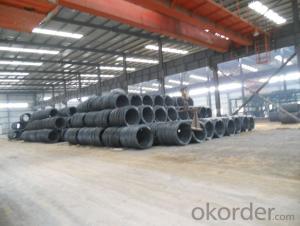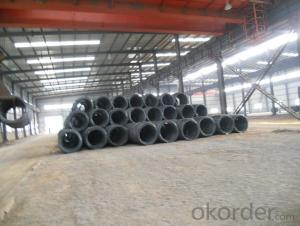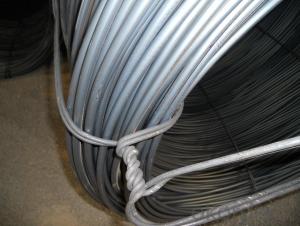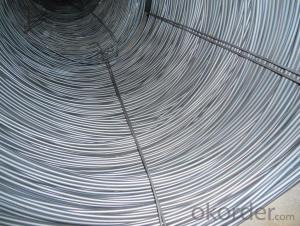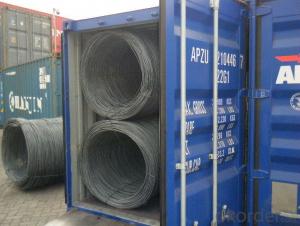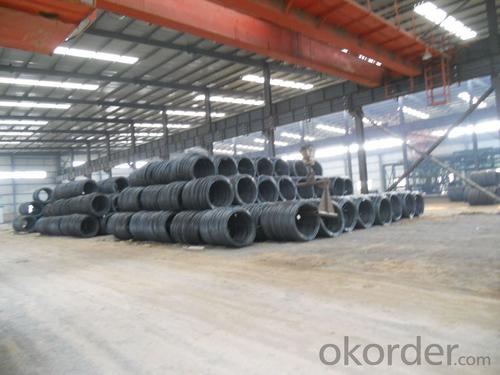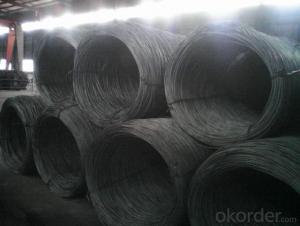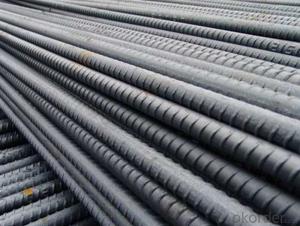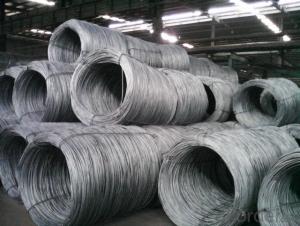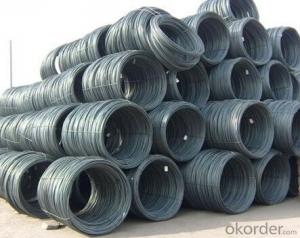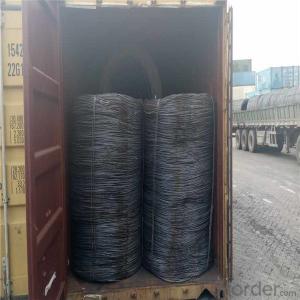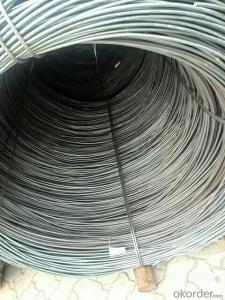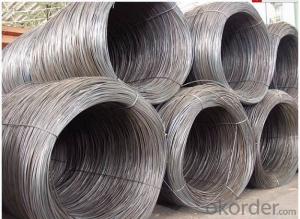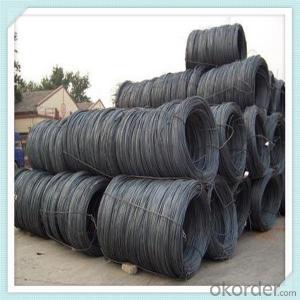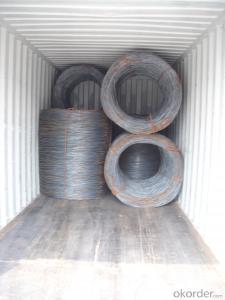Stainless Wire Rod SAE1006B of Standard ASTM
- Loading Port:
- Tianjin
- Payment Terms:
- TT OR LC
- Min Order Qty:
- 100 m.t.
- Supply Capability:
- 2000 m.t./month
OKorder Service Pledge
OKorder Financial Service
You Might Also Like
Product Description:
OKorder is offering Stainless Wire Rod SAE1006B of Standard ASTM at great prices with worldwide shipping. Our supplier is a world-class manufacturer of steel, with our products utilized the world over. OKorder annually supplies products to European, North American and Asian markets. We provide quotations within 24 hours of receiving an inquiry and guarantee competitive prices.
Product Applications:
Stainless Wire Rod SAE1006B of Standard ASTM for structural applications and are widely used in the construction of buildings and bridges, and the manufacturing, petrochemical, and transportation industries.
Product Advantages:
OKorder's Stainless Wire Rod SAE1006B of Standard ASTM are durable, strong, and resist corrosion.
Main Product Features:
· Premium quality
· Prompt delivery & seaworthy packing (30 days after receiving deposit)
· Corrosion resistance
· Can be recycled and reused
· Mill test certification
· Professional Service
· Competitive pricing
Specifications of Stainless Wire Rod SAE1006B:
Steel Grade: SAE1006B Standard: ASTM
Diameter: 5.5mm, 6.5mm, 7mm,8mm,9mm,10mm,12mm,14mm
Diameter Tolerance: +/-0.3mm
Package: as customer required
Type: in Coil, each coil weight around 2MT Coil Diameter: about 1.2M Coil Length: 1.6-1.7M
Brand Name: N-RIVER Technique: Hot Rolled
Place of Origin: Hebei, China Mainland
Chemical Composition:
Please kindly find our chemistry of our material based on SAE1006B as below for your information
Grade | Chemical Composition (%) | |||||
C | Mn | S | P | Si | B | |
SAE1006B | 0.03~O.07 | 0.32max | 0.045max | 0.040max | 0.30max | 0.0008min |
Mechanical properties | ||||||
Yield strength(N/mm2) | Tensile strength(N/mm2) | Elongation (%) | ||||
250-280 | 350-380 | ≥32 | ||||
Usage and Applications of Stainless Wire Rod SAE1006B:
After hot-rolled the products shaped into coil and delivery as finished product, including round, square, rectangular, hexagonal and so on. Since most of the products are round, it is generally called wire rod. Carbon steel wire rod is widely used in construction and manufacturing. Carbon steel wire rod is mainly used for reinforcement of reinforced concrete and welded structure or reprocessed (roberts , nail, etc.) materials, especially used to produce wire drawing, welding electrode, nails, spring, electronic, precise machinery parts and so on.
Packaging & Delivery of Wire Rod SAE1006B:
Packaging Detail: products are packed in coil and then shipped by container or bulk vessel
Each coil weight: 2-3MT
Delivery Time: within 45 days after received advanced payment or LC.
Label: to be specified by customer, generally, each bundle has 1-2 labels
Trade terms: FOB, CFR, CIF
Note:
1. Our products are produced according to national standard (GB), if not, supply according to national standards (GB) or agreement as customer required.
2. Other Grade and Standard carbon steel wire rod we can supply:
Grade: H08A, 30MnSi, 62B-82B
Standard: AISI, BS, JIS, DIN
The Minimum Order Quantity of these products is high, and need to be confirmed.
3. We can not only supply carbon steel wire rod; if you need anything about building materials, please contact us.
4. Please send us your detail specifications when inquire. We will reply to you as soon as possible. We sincerely hope we can establish a long stable business relationship.
FAQ:
Q1: Why buy Materials & Equipment from OKorder.com?
A1: All products offered byOKorder.com are carefully selected from China's most reliable manufacturing enterprises. Through its ISO certifications, OKorder.com adheres to the highest standards and a commitment to supply chain safety and customer satisfaction.
Q2: How do we guarantee the quality of our products?
A2: We have established an advanced quality management system which conducts strict quality tests at every step, from raw materials to the final product. At the same time, we provide extensive follow-up service assurances as required.
Q3: How soon can we receive the product after purchase?
A3: Within three days of placing an order, we will begin production. The specific shipping date is dependent upon international and government factors, but is typically 7 to 10 workdays.
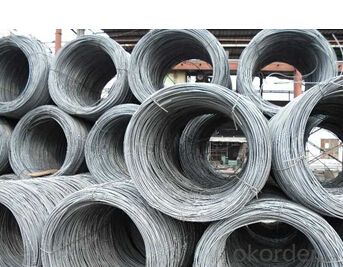

- Q: How is steel wire rod used in the production of conveyor belts?
- Conveyor belts rely heavily on steel wire rod, an essential component in their manufacturing process. Its primary function is to reinforce and strengthen the structure of conveyor belts, ensuring their durability and reliability. To create conveyor belts, steel wire rod undergoes a series of mechanical processes, including hot rolling, cold drawing, and annealing, to transform it into thin, elongated wires. These wires are then twisted and braided together, forming a robust and flexible steel cord. The steel cord is embedded within the core of the conveyor belt, providing exceptional tensile strength and resistance to stretching. This reinforcement allows conveyor belts to bear heavy loads and endure high tension without breaking or deforming. Furthermore, the steel cord enhances the conveyor belt's ability to withstand impact, abrasion, and tearing. Aside from their structural advantages, steel wire rods used in conveyor belts offer additional benefits. They possess high thermal stability, ensuring that the conveyor belt can operate safely even in extreme temperatures. Additionally, the steel cord is highly resistant to corrosion, preventing premature deterioration of the conveyor belt. Overall, steel wire rod plays a vital role in the production of conveyor belts, furnishing the necessary strength and durability for efficient operation. It guarantees that conveyor belts can transport materials smoothly and reliably across various industries, such as mining, manufacturing, and logistics.
- Q: What are the different types of tests performed on steel wire rod?
- There are several types of tests performed on steel wire rod to ensure its quality and suitability for various applications. These tests include: 1. Chemical Composition Analysis: This test determines the percentage of different elements present in the steel wire rod, such as carbon, manganese, silicon, sulfur, phosphorus, and other trace elements. It helps to ensure that the steel meets the required specifications. 2. Tensile Strength Test: This test measures the ability of the steel wire rod to withstand tension or pulling forces without breaking. It determines the maximum load the rod can bear before it fractures, providing crucial information about its strength and durability. 3. Elongation Test: This test determines the percentage increase in length the steel wire rod undergoes before it breaks under tension. It helps to assess the ductility and malleability of the rod, indicating its ability to withstand deformation without fracturing. 4. Hardness Test: This test measures the resistance of the steel wire rod to indentation or scratching. It provides an indication of the material's strength and ability to resist wear and tear. 5. Microstructure Analysis: This test involves examining the microstructure of the steel wire rod under a microscope. It helps to identify any structural anomalies, such as grain size, presence of inclusions, and uniformity, which can affect the rod's mechanical properties. 6. Surface Inspection: This test involves visually inspecting the surface of the steel wire rod for any defects, such as cracks, scratches, or surface irregularities. It ensures that the rod meets the required visual quality standards. 7. Dimensional Inspection: This test verifies the dimensional accuracy and tolerances of the steel wire rod, such as diameter, length, and straightness. It ensures that the rod meets the specified dimensional requirements for its intended application. 8. Corrosion Resistance Test: This test evaluates the steel wire rod's ability to resist corrosion when exposed to different environmental conditions. It helps to determine the rod's suitability for applications where corrosion resistance is critical. By performing these tests, manufacturers can ensure that the steel wire rod meets the necessary quality standards and is suitable for use in various industries, including construction, automotive, manufacturing, and infrastructure.
- Q: How is the steel wire rod market affected by mergers and acquisitions?
- The steel wire rod market can be significantly affected by mergers and acquisitions. When companies merge or acquire other companies in the industry, it often leads to consolidation and concentration of market share. This can result in increased pricing power, reduced competition, and a more streamlined supply chain. Additionally, mergers and acquisitions can also lead to the integration of complementary technologies and expertise, which may enhance the overall efficiency and innovation in the market. However, it is important to note that such transactions require regulatory approvals and can lead to potential challenges in terms of market competition and fair pricing practices.
- Q: What are the different weldability testing methods for steel wire rod?
- There are several different weldability testing methods for steel wire rod. These include the macroscopic examination, which involves visually inspecting the weld for any defects or anomalies; the bend test, where the weld is bent to evaluate its ductility and resistance to cracking; the tensile test, which measures the strength and elongation of the weld; the hardness test, which determines the hardness of the weld and its susceptibility to cracking; and the impact test, which assesses the weld's ability to withstand sudden loads and impacts.
- Q: What are the different testing methods for steel wire rod?
- There are several different testing methods that can be used to evaluate the quality and characteristics of steel wire rods. Some of the most common testing methods include: 1. Tensile Testing: This method involves subjecting the steel wire rod to tension until it breaks. It helps to measure the maximum load the rod can bear and provides information about its tensile strength, yield strength, and elongation. 2. Bend Testing: In this method, the steel wire rod is bent to a specific angle and examined for any cracks or fractures. It helps to assess the rod's ductility and resistance to deformation. 3. Hardness Testing: This method measures the hardness of the steel wire rod using various techniques such as Rockwell, Brinell, or Vickers hardness tests. It determines the material's ability to resist indentation or penetration. 4. Microscopic Examination: This method involves examining the microstructure of the steel wire rod under a microscope. It helps to assess the material's grain size, inclusion content, and overall quality. 5. Chemical Analysis: This method involves analyzing the chemical composition of the steel wire rod. It helps to ensure that the rod meets the required specifications and standards. 6. Ultrasonic Testing: This non-destructive testing method uses high-frequency sound waves to detect any internal flaws or defects in the steel wire rod. It helps to assess the rod's integrity and identify any potential weaknesses. 7. Dimensional Inspection: This method involves measuring the physical dimensions of the steel wire rod to ensure it meets the specified tolerances and requirements. By employing these testing methods, manufacturers and quality control personnel can ensure that steel wire rods meet the necessary standards for their intended applications.
- Q: How is the weldability of steel wire rod evaluated?
- The weldability of steel wire rod is evaluated using various techniques and criteria. One of the key factors in assessing weldability is the chemical composition of the steel wire rod. The presence of certain elements, such as carbon, sulfur, and phosphorus, can significantly impact the weldability of the material. Additionally, the mechanical properties of the steel wire rod, such as its tensile strength, ductility, and toughness, are important considerations. These properties can affect the quality and integrity of the weld joint. Another factor to evaluate weldability is the surface condition of the steel wire rod. Any contaminants or impurities on the surface can negatively affect the weldability and lead to defects in the weld. Furthermore, the welding process and parameters used play a crucial role in determining the weldability of steel wire rod. Factors such as heat input, welding speed, and shielding gas selection need to be optimized to ensure proper fusion and minimize the risk of defects. To evaluate the weldability, various tests and inspections are conducted. These include visual examination of the weld for defects like cracks, porosity, or lack of fusion. Non-destructive testing methods like ultrasonic testing or radiography can be used to detect any internal flaws or inconsistencies. Additionally, mechanical tests like tensile and bend testing are performed to evaluate the strength and ductility of the weld joint. These tests help assess the overall quality and performance of the welded steel wire rod. In summary, the weldability of steel wire rod is evaluated by considering factors such as chemical composition, mechanical properties, surface condition, welding process, and conducting tests and inspections to ensure the quality and integrity of the weld joint.
- Q: How is steel wire rod used in the manufacturing of wire forms for automotive cooling systems?
- Steel wire rod is used in the manufacturing of wire forms for automotive cooling systems as it provides strength, durability, and resistance to corrosion. These wire forms are utilized in various components such as radiator support brackets, fan guards, and hose clamps. The steel wire rod is first drawn into the desired diameter and then undergoes processes like bending, cutting, and welding to create the required wire forms. These wire forms play a crucial role in ensuring the efficiency and functionality of automotive cooling systems by providing structural support, securing components, and maintaining proper airflow.
- Q: What are the different types of steel wire rod coatings used for enhanced wear resistance?
- To enhance wear resistance, steel wire rods commonly utilize different types of coatings. These coatings are applied to the surface of the wire rod, providing a protective layer that improves durability and longevity. One method for enhancing wear resistance is through the use of zinc coatings. Known as galvanizing, this process involves immersing the steel wire rod in molten zinc. As a result, a layer of zinc forms on the wire's surface, acting as a barrier against corrosion and wear. Zinc coatings are often used in environments with harsh conditions or high levels of moisture. Another approach to wear resistance is the application of polymer coatings. Typically, these coatings are a thin layer placed on the surface of the steel wire rod. They create a protective barrier against abrasion, chemicals, and other forms of wear. Polymer coatings can be customized to possess specific properties, such as resistance to high temperatures, low friction, or specific chemicals. Consequently, they are suitable for a wide range of applications. Additionally, ceramic coatings are employed to enhance wear resistance in steel wire rods. The application of ceramic coatings is typically achieved through a chemical or physical vapor deposition process. These coatings create a thin layer of ceramic material on the wire rod's surface, offering excellent resistance to wear, corrosion, and high temperatures. Ceramic coatings are commonly used in scenarios involving extreme conditions or high levels of friction. In conclusion, there are several types of steel wire rod coatings used to enhance wear resistance. Zinc coatings provide protection against corrosion, polymer coatings offer resistance to abrasion and chemicals, and ceramic coatings excel in resistance to wear, corrosion, and high temperatures. The choice of coating depends on the specific application and the desired level of wear resistance required.
- Q: How are steel wire rods used in the production of wire ropes for heavy lifting?
- Steel wire rods are crucial in the production of wire ropes for heavy lifting due to their strength, durability, and versatility. Wire ropes are essential for heavy lifting as they provide the necessary strength and support to lift and move heavy objects safely. Steel wire rods serve as the raw material for wire rope production. These rods are typically made of high-quality, high-carbon steel, which has excellent tensile strength and resistance to wear and tear. The wire rods are first cleaned and coated to prevent corrosion, ensuring the longevity and reliability of the wire ropes. The manufacturing process begins with the wire rods being drawn through a series of dies to reduce their diameter and increase their length. This process is called wire drawing and is crucial for increasing the tensile strength of the wire. The drawn wires are then twisted together in a specific pattern to form strands. Multiple strands are then twisted together in a helical pattern around a core to form the final wire rope. The core can be made of either hemp, steel, or synthetic materials, depending on the specific application and load requirements. The use of steel wire rods in wire rope production ensures that the resulting wire ropes possess the necessary strength and durability to handle heavy lifting operations. They can withstand immense tension and can bear heavy loads without deforming or breaking. This is especially important in industries such as construction, mining, and maritime, where heavy lifting operations are common. Moreover, steel wire rods provide excellent resistance to abrasion, corrosion, and fatigue, making wire ropes suitable for harsh environments and prolonged use. These properties are crucial for heavy lifting applications, as the wire ropes need to maintain their integrity and reliability even under extreme conditions. In summary, steel wire rods are a fundamental component in the production of wire ropes for heavy lifting. They provide the necessary strength, durability, and versatility to ensure the safety and efficiency of heavy lifting operations in various industries.
- Q: What are the different sizes and dimensions of steel wire rod?
- Steel wire rods are available in a variety of sizes and dimensions to accommodate different industrial and commercial uses. The intended use and manufacturing standards typically determine the sizes and dimensions of steel wire rods. The diameter of steel wire rods can vary from as small as 0.1 millimeters (mm) to as large as 60 mm or more. Generally, the most common sizes in the market range between 5 mm and 20 mm in diameter. However, specialized applications may necessitate wire rods with larger or smaller diameters. The length of steel wire rods can vary significantly depending on the requirements. They are often produced in coils, which can range in length from a few meters to several kilometers. The length of wire rods can be customized to meet the customer's needs or industry standards. Regarding dimensions, steel wire rods are typically manufactured in a round shape. However, they can also be produced in other shapes such as square, rectangular, or hexagonal, depending on the specific application. The most prevalent shape is round because it provides excellent strength and flexibility for various uses. Furthermore, the weight of steel wire rods can vary based on the diameter and length. Usually, the weight is measured in kilograms (kg) or pounds (lb). The weight per unit length is determined by the specific gravity of the steel and the diameter of the wire rod. In conclusion, the sizes and dimensions of steel wire rods are extensive and can be customized to meet specific requirements. Whether it is for construction, automotive, or other industries, steel wire rods are available in a wide range of sizes to accommodate various applications.
Send your message to us
Stainless Wire Rod SAE1006B of Standard ASTM
- Loading Port:
- Tianjin
- Payment Terms:
- TT OR LC
- Min Order Qty:
- 100 m.t.
- Supply Capability:
- 2000 m.t./month
OKorder Service Pledge
OKorder Financial Service
Similar products
Hot products
Hot Searches
Related keywords
